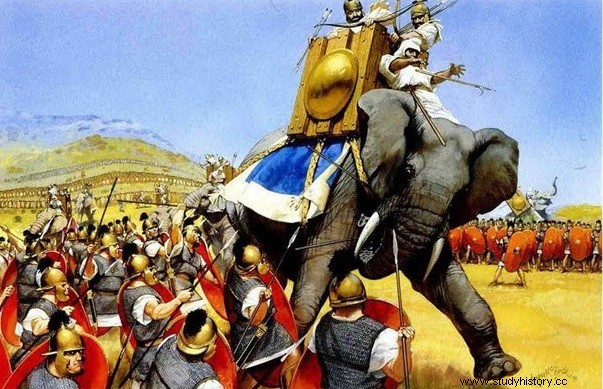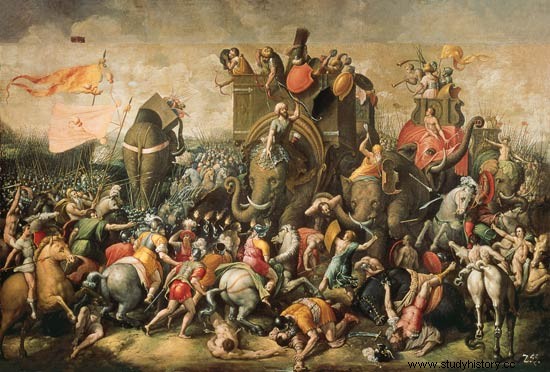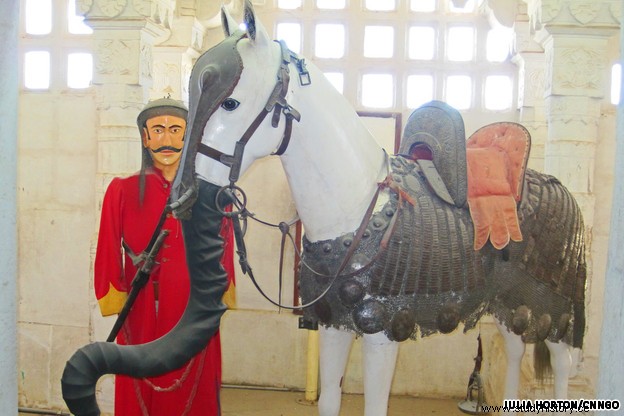Throughout history there have been many who have had to face the fearsome war elephant, the tanks of Antiquity , but only some like Publius Cornelius Scipio , the besieged in the city of Megara , Tamerlane and the brave rajputs they knew how to face them and defeat them.
The Carthaginians used them in their clashes with the Romans during the Punic Wars but it was in the battle of Zama (near Carthage, present-day Tunisia) in 202 B.C. when the Romans knew how to defeat them. In Zama two of the great strategists of history faced each other:Aníbal and Publius Cornelius Scipio . When Scipio moved from Hispania to North Africa, Hannibal had to forget his dream of occupying Rome and rush back to defend his homeland. The Carthaginian recruited an army, with more haste than desired, among which he had 80 elephants for the vanguard. Unfortunately, many of the elephants were still young and not fully trained. When both armies were facing each other in the plains of Zama, Scipio ordered the horns and trumpets to sound and the drums to beat... that noise frightened the young elephants who fell back and disrupted the Carthaginian formation. Scipio attacked with his infantry taking advantage of the confusion and launched the Numidian cavalry, with the traitor Masinissa to the front, to attack the wings. The Roman victory marked the end of the Second Punic War and the exile, years later, of Hannibal.

In the War of Cremonides , 3rd century BC C., a coalition of various Greek city-states and Ptolemy II , the second pharaoh of the Ptolemaic dynasty, faced the Macedonian king Antigonus II Gonatas . The declaration of war was made by the Athenian Cremonides , hence the name of the war. In the siege of the Macedonian troops to Megara , city-state that was part of the coalition, one of the main forces besieging the city were the war elephants. To get rid of the siege of the pachyderms, we had to eliminate ourselves... taking advantage of the fact that they are skittish animals, they released a herd of pigs, on which they had previously poured oil, and set them on fire. The elephants, before that mass of fire that came towards them emitting thunderous cries, they left in a stampede killing many Macedonians. The inhabitants of Megara took advantage of the chaos and broke the siege.

Tamerlane he was a Mongol Muslim nobleman, of Turkish origin, who came to conquer eight million square kilometers in Eurasia. From Samarkand (present-day Uzbekistan), the capital of his empire, extended his domains through present-day Syria, Iraq, Iran, Pakistan, Afghanistan, Turkmenistan, Uzbekistan, part of India, Turkey, Russia... His strategic brilliance in conquest campaigns was tarnished with samples of genocide and the destruction of entire populations. In 1398 he began the Indian campaign to conquer the sultanate of Delhi , ruled by Sultan Nasir-u Din Mehmud , on the pretext that the sultanate was too tolerant of its Hindu subjects, but the real reason was to increase its domains. After crossing the river Indus Tamerlane met the vanguard of Sultan Mehmud's army… 120 armored elephants with their tusks impregnated with poison. That sight petrified the invading army, but not Tamerlane... he knew that elephants were very skittish, so he ordered his camels to be loaded with straw and wood and after setting fire to the load they threw them at the elephants, pricking them with irons in their hindquarters. . At this stampede of fireballs and sounds of pain (I don't know what the sound camels make is called, but it was surely pain) the elephants turned and in their flight destroyed the infantry behind them. It was a very easy victory, but the worst was left:
Tamerlane entered Delhi and the city was looted and destroyed… 10,000 Hindus were slaughtered and their women, children and property became the spoils of the victors. Other sources speak of 100,000.

Tamerlane
Rajasthan it is currently the largest of the northwestern states of India. It was formerly known as Rajput , the kingdom of the Rajputs, since since the 6th century it was ruled by the Rajput warrior caste, a Sanskrit term meaning sons of the king. The conquest of the Muslims in the twelfth century, with the subsequent creation of the Delhi sultanate, and the incursions of the Mughal Tamerlane in the fourteenth century, the Indian subcontinent was divided into several states:some Muslim, others forming part of the Mughal Empire... until that in the mid-19th century, most of India was under the control of the British East India Company . During all these centuries of raids, conquest and domination, the state of Rajasthan remained independent, to varying degrees, thanks to the brave Rajputs… and their Marwari horses. . Each Rajput raised and educated his own horse, always of the Marwari breed, which would later be his companion in battle. This breed has been characterized by its intelligence, loyalty and bravery. In addition, physically, it has a distinctive mark… pointed ears with the tips facing inwards, even touching each other. When the Rajputs had to face the Mughal elephants, they decided to use their imagination:they gave their horses a kind of trunk to fool the adult elephants and make them believe that they were young elephants, which would allow them to approach them without being attacked.

Rajput and his Marwari elephant
